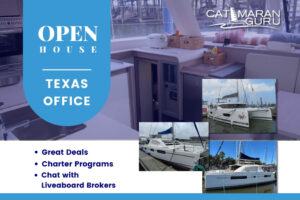Here are all the choices of sailboat charters you will find. We will tell you which one fits best your requirements and sailing skills. You will also read about budgeting your cruise.
Types of Charters
Bareboats
By far the most popular category and the most widely available worldwide. There is probably not one nice navigation area in the world that does not shelter a charter company of some sort.
When you bareboat, you sail the boat yourself, from A to Z, and you are entirely responsible. The person in charge of the charter needs to have skippering experience on a yacht close to the size you intend to charter.
Charter companies will require you to provide your sailing résumé, before they confirm the charter as a bareboat. Now, are all Charter Companies thoroughly checking your resume and will they turn your business down if you’re not up to par? I am not sure it is always the case, especially when I observe some bareboat charterers’ seamanship behavior (or lack of thereof). Some of them seem to have absolutely no clue as to what they’re doing and are a potential danger to themselves and to others.
But a reputable charter company will require that you hire a skipper for the first couple of days (or maybe the whole cruise) if it appears you are not competent enough to warrant the boat’s and the crew’s safety. (See below: Skippered bareboat.) In any case, we strongly suggest that you do not overestimate your skills.
As the skipper, you will be responsible of the keeping and sailing of the boat, and of your crew’s safety. Before leaving the dock though, you will get a thorough chart briefing, and a boat briefing to show you all the boat’s systems. You are also in charge of the food provisioning. Most companies will supply it if you want, but you can do your food shopping yourself as well.
Skippered Bareboats
You are still using a bareboat but you add a free-lance skipper for all or part of the cruise. The Charter Company will choose and provide the skipper for your party. And by the way, this is extra –between $100 and $140 per day depending on the areas. You are also responsible for feeding the skipper.
This is good option if you want to eventually bareboat, but don’t feel comfortable enough in your skills yet; or if you are discovering a new or challenging sailing area and feel the need to have a guide for a couple of days.
Caution: this can add up almost to the same price as some fully crewed yachts (see below). However, the Charter Company or the charter broker will not match your party’s interests with the skipper’s.
Fully Crewed Charters
The yacht comes with a permanent, live aboard captain and cook/chef, usually husband and wife. Crewed yachts tend to be larger, more luxurious than bareboats, and usually have more “toys”, like a windsurf or a kayak. Some even offer scuba diving or water-skiing.
Remember: The secret of an enjoyable crewed charter is essentially the crew, and not only the boat. Of course, the boat has to be adequate, but the crew will make or break your cruise. A broker will help a lot for this. (See about using a broker in ‘Choosing a Charter Company’.)
On a crewed yacht, it is entirely up to you to be just a relaxed luxury vacationer, or to participate in the sailing, or to learn new skills from the skipper. In most cases, if you so desire, the captain will let you steer or handle some sailing chores under his supervision. You and your party choose, with the guidance of the captain, the day’s activities and the itinerary, on a day-to-day basis.
Remember though: Ultimately, the Captain is in charge, not you. In other words, if he deems that some previously selected destination is no longer suitable (poor weather, rolly anchorage, or any safety reason), he will have the last word and change the plans according to his judgment. If he is a good skipper, he will be very diplomatic about this and find a nice replacement destination. But do not expect him to compromise safety just to make you happy.
Price includes all meals and often house wines and open bar. The meals are prepared to your taste to a relatively high standard -variable depending on the level of the yacht.
Cost fine print: You will not find this in bold letters in your charter contract. It is customary and expected to tip your crew, as gratuities represent about 30 to 50% of their income. The amount should be between 10 to 15% of the cost of your cruise. So if your charter cost $10,000, and you are satisfied of the service you received, you are expected to give a gratuity between $1,000 and $1,500. This is a significant amount of money and many charterers don’t realize this or simply don’t even know it! Do not make any mistake though: Crews usually deserve this, as their job is very hard. Much harder than it looks. So make sure you compute the gratuity in your vacation cost.
Sailing Schools and Flotillas
Schools
If you do not have a water body near where you live, you can choose to go for a week of charter with a sailing school. You will combine a serious learning experience complete with a real curriculum, with the pleasure of sailing in a great cruising area. It is an excellent way to develop your sailing skills from small boat handling to charter boat size. The students are typically responsible for running the boat under the guidance of a professional instructor. Bear in mind that the usual prerequisite for such charters is the knowledge of basic sailing, or a “Learn to sail” certificate from the same school. Most sailing schools will give you a Diploma at the end of the charter, which you’ll be able to present with your sailing resume to the charter company. We, at Sailonline.com, like Offshore Sailing School of Steve Colgate (Offshore is not a paying advertiser.)
Flotillas
After having spent a week with a school, you might want to upgrade to a flotilla (see article on flotillas). It is usually organized by a charter company, in which a group of boats sails together on the same pre-designed itinerary and anchors or moors in the same anchorage at night. The good side: more comfortable and less stressful for the boat skippers who receive chart and hazards briefings every morning. The less good side: the skippers are not free to sail wherever they want. However, it is usually a nice social and sailing experience.
Single Stateroom
The Moorings has pioneered this new formula over the last 3 years. Moorings use yachts with 4 double cabins/4 heads for their all-inclusive “Stateroom Package”. The professional crew of 2 occupies 1 cabin; the 3 other cabins are shared by 3 other couples who do not know each other. The good side is that you have the benefits of a fully crewed yacht at a reasonable cost and you can meet nice new friends. The risk is that you might not necessarily get along with the other couples.
Your Budget
All charter types described above have of course different budget implications. They all differ too much from one company or boat to the next to detail them here. However, you will easily find all the cost information you need from the charter companies’ advertising material. Here are some considerations about your charter cruise budget.
The first thing to do is to determine your total budget for your cruise. Then, from the charter companies’ material, choose the ideal boat size you’d like: the cost of the boat will be your main expense, which you will probably share with your crew. Add to that your traveling costs (airfare, transportation to and from the base, airport taxes).
TIP: Charter companies almost always offer special discounts during boat shows, so it’s a good time to book during those.
Your next large expense will be the food provisioning. You can choose to buy it from the charter company (the easy way): You choose your items from the food sheet well before you leave for your cruise. Charter companies will charge you a flat rate of typically $25/30 p.day and p.person. Pros: you save at least 1/2 day on your vacation, because the provisions are delivered straight to your boat and stocked before you even arrive. Cons: usually not really cheap; difficult to verify the quality.
Or you can provision yourself from the local supermarket upon your arrival, or even bring your food from home, and just buy the beverages at the base. I know many very organized people who routilnely do this and save a bundle on it. Do not bring fresh produce though, as Customs agents will not let you in. For canned food you bring in, if questioned by the customs upon arrival, simply say you are on a medical diet. Pros: You save money; you get exactly what you want/need. Cons: You waste time as it is usually a bit of a hassle.
Of course, remote charter areas are more difficult for do-it-yourself provisioning. In either case, keep some extra money in reserve because you will certainly dine ashore a couple of times, and buy some additional goodies, wine, bakery, etc. during the cruise.
Lastly, ask very specific questions to the charter company about all extras (usually in fine print) like: cruising licenses, fishing licenses, marine park fees, various local taxes, fuel and water cost (are they included?), dinghy gasoline etc.
Once you have done all that, if your budget is really too tight, we suggest you consider choosing one size down for the boat or going at low season for example, since vacationing with constant money worries is not too much fun.
Secrets to Making a Successful Charter
A charter is not like any other trip you’d take with friends, mainly because you are going to undertake a small expedition in a closed environment (the boat) with no possible escape. So our main advice is to choose your crew very carefully. No whiners, short fused or impatient people. Choose a crew you know you are compatible with. There will always be unexpected circumstances: bad weather, or food being not exactly what you would like, etc. Your crew will have to be able to take this with good humor and grace.
Another key word is preparation. Personally, I enjoy working my itinerary, putting the navigation together and choosing nice restaurants along the way. You should do this properly, and possibly with your crew. It is a nice opportunity to start the fun early and somewhat assess how your crew will behave.
Lastly, it is a good idea to have an undisputed skipper who will have the last word in problematic situations. A boat with two skippers is a fight waiting to happen!






